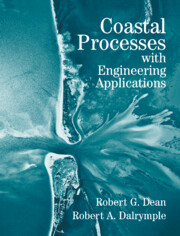Book contents
- Frontmatter
- Contents
- Preface
- Acknowledgments
- PART ONE INTRODUCTION TO COASTAL PROCESSES
- PART TWO HYDRODYNAMICS OF THE COASTAL ZONE
- PART THREE COASTAL RESPONSE
- PART FOUR SHORELINE MODIFICATION AND ANALYSIS
- 11 Beach Fill and Soft Engineering Structures
- 12 Hard Engineering Structures
- 13 Tidal Inlets
- 14 Shoreline Management
- Author Index
- Subject Index
11 - Beach Fill and Soft Engineering Structures
Published online by Cambridge University Press: 29 May 2010
- Frontmatter
- Contents
- Preface
- Acknowledgments
- PART ONE INTRODUCTION TO COASTAL PROCESSES
- PART TWO HYDRODYNAMICS OF THE COASTAL ZONE
- PART THREE COASTAL RESPONSE
- PART FOUR SHORELINE MODIFICATION AND ANALYSIS
- 11 Beach Fill and Soft Engineering Structures
- 12 Hard Engineering Structures
- 13 Tidal Inlets
- 14 Shoreline Management
- Author Index
- Subject Index
Summary
In the early 1970s, much of Miami Beach, Florida, was badly eroded, lined with seawalls, and compartmented by long steel groins, making it impossible for tourists to walk along the beach. The numbers of visitors to Miami Beach and hotel occupancy rates were declining and, at high tide during storms, the impact of large waves against the seawalls and the resulting vibrations were reported to be worrisome to guests in the upper (more expensive) rooms.
From 1976 to 1981, the Miami Beach Nourishment Project was undertaken, widening the beach by 100 m over a length of 16 km. The project extends from Bakers Haulover Inlet at the north to Government Cut Inlet at the south. Both of these termini have large, relatively impermeable jetty structures to prevent end losses from the project. The project required in excess of 10 million m3 of sand obtained from offshore borrow areas by large hydraulic dredges, and it cost $64 million (1980 USD).
The construction of the nourishment project took place in the midst of rising concern over the effects and effectiveness of shoreline projects. The project attracted negative publicity by receiving the Golden Fleece Award that was given annually by a popular senator to the project deemed to be the greatest waste of public funds. There were other outspoken claims that the project would wash away with the first major storm and was a waste of money.
- Type
- Chapter
- Information
- Coastal Processes with Engineering Applications , pp. 343 - 386Publisher: Cambridge University PressPrint publication year: 2001



